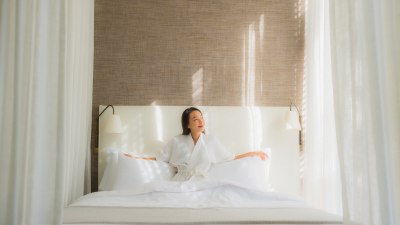Why Every Hotel Bed Either Feels Like a Cloud or a Rock
Explore the reasons behind the varying comfort levels of hotel beds and how they impact your stay.

Image by lifeforstock on Freepik
When checking into a hotel, one of the major factors that can affect your stay is the comfort level of the bed. You may have noticed that hotel beds often fall into two distinct categories: they either feel like sleeping on a soft, fluffy cloud or like resting on a hard, unyielding rock. This phenomenon begs the question: what are the reasons behind these contrasting experiences? In this article, we will delve into the world of hotel mattresses, explore different types of bedding, and understand the factors influencing how we perceive comfort in hotel rooms.
The Importance of a Good Night's Sleep
Getting quality sleep is essential for our overall health and well-being. It affects our mood, energy levels, and mental clarity. Hotels understand this and invest in various aspects of their bedding to provide guests with a comfortable experience. However, the differences in mattress types can create varied experiences. A good night’s sleep directly impacts a guest’s satisfaction with their stay, making it integral for hotels to provide the best they can offer.
Types of Hotel Mattresses
The primary reason for the stark contrast between hotel beds is the type of mattresses utilized. Hotels tend to use several common mattress types, each with unique attributes. Understanding these types can shed light on why some beds feel cloud-like while others feel rock-solid.
Innerspring Mattresses
Innerspring mattresses are perhaps the most traditional and commonly used in hotels. They generally consist of a coil support system topped with some layer of cushioning. While these mattresses provide good support and can feel firm, the level of comfort often depends on the padding materials. Hotels may opt for a thicker layer of foam or padding to create a softer sleeping surface.
Memory Foam Mattresses
Memory foam mattresses have gained popularity over the years due to their ability to conform to the body. These beds can provide a cloud-like feel by evenly distributing body weight and alleviating pressure points. Many upscale hotels invest in memory foam mattresses to create a plush sleeping experience for their guests, which can be particularly desirable for those who value comfort.
Latex Mattresses
Latex mattresses are another option that hotels may choose. These beds can range from soft to firm and often provide a buoyant feel. They're crafted from natural or synthetic rubber and are noted for their durability and breathability. Depending on how a latex mattress is constructed, it can feel more supportive than a memory foam mattress, leading some guests to find them firmer and less cloud-like.
Hybrid Mattresses
Hybrid mattresses combine various materials, such as innerspring coils and memory foam, to create a mattress that offers the best of both worlds. The top layer often consists of plush foam or latex, providing the cloud-like comfort many guests desire, while the supportive coils underneath ensure adequate firmness. Hotels may explore hybrid options to cater to guests' diverse preferences.
Personal Preferences and Perception
Comfort is highly subjective, and personal preferences play a significant role in how guests perceive a bed's firmness. Some visitors may prefer the enveloping sensation of a softer mattress, believing it to be akin to sleeping on a cloud. In contrast, others may find comfort in a firmer bed that offers more support. Hotels often try to cater to these varying preferences by offering different types of mattresses or bed configurations.
The Role of Bed Accessories
The overall experience also depends on the bed accessories used in tandem with the mattress. Pillows, sheets, and comforters heavily influence comfort levels. A hotel may provide a soft, fluffy duvet paired with generous pillows, creating that cloud-like atmosphere. Conversely, a lack of adequate bedding could contribute to the sense of sleeping on a rock.
Pillow Options
Pillows can be a game-changer in the quest for comfort. Many hotels now offer a pillow menu allowing guests to choose from various options, including memory foam, hypoallergenic, and down pillows. The right pillow can significantly impact a guest's ability to sleep well, working in conjunction with the mattress to create an overall comfortable experience.
Bedding Quality
The quality of linens also plays an essential role in the comfort level of hotel beds. Luxurious and breathable sheets can enhance the softness of the bed, while high thread count sheets add to the plush experience. Hotels aiming for a higher caliber experience often invest in premium bed linens, contributing to that superb cloud-like sensation.
Feedback and Reviews
Guest feedback and online reviews can also inform hotels about the comfort level of their beds. Many hotels will use customer satisfaction surveys or online review sites to gauge how guests feel about their mattresses. If guests consistently mention a bed is uncomfortable, hotels may look for alternatives or switch mattress types to improve overall satisfaction.
The Impact of Branding
Branding often plays a part in the type of bed a hotel chooses to feature. High-end brands may opt for more luxurious mattresses to align with their customers' expectations for comfort and quality. In contrast, budget hotels might provide more basic mattress options, which may feel less comfortable by comparison. The branding of a hotel can set the stage for what guests expect, whether it be a rock-hard sleep or a cloud-like experience.
Trends in Hotel Bedding
As more travelers become knowledgeable about sleep hygiene and comfort, hotels are adapting to these trends. Many are investing in innovative mattress technology, such as adjustable beds that allow guests to customize their sleeping positions. Moreover, the growing awareness around sustainable and organic materials has led some hotels to offer eco-friendly mattress options, giving guests a choice for their sleep experience.
In conclusion, the reason why hotel beds either feel like a cloud or a rock can be attributed to several factors, including the type of mattress used, the quality of bedding, personal preferences, and branding. While some guests may revel in the soft embrace of a plush mattress, others may prefer the solid support of a firmer option. Regardless of preference, hotels are continually adapting to meet guests’ needs to ensure everyone has a restful experience. So on your next hotel stay, take note of the bed you’ll encounter and appreciate the thought that goes into providing you with a good night’s sleep.











